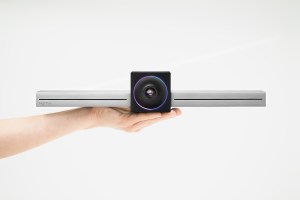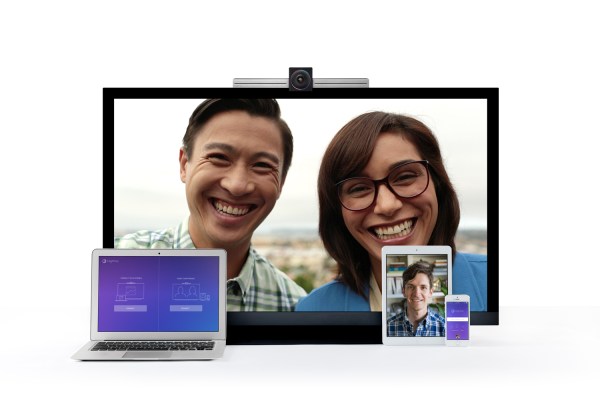Video conferencing and collaboration could unlock new levels of productivity in teams, but to date most video conferencing solutions have been out of reach for the majority of businesses and applications. That’s because today they typically require expensive proprietary hardware installations, along with software systems that weren’t built for an increasingly mobile workforce.
A startup called Highfive wants to massively change that, with a sleek piece of hardware and a cloud-based video conferencing suite that will make face-to-face communications affordable and accessible even for small and medium-sized businesses.
It’s been nearly a year since we first wrote about Highfive, a startup founded by Shan Sinha and Jeremy Roy, the guys behind Docverse. They had sold their previous company to Google years prior, and were looking to find new ways to help teams communicate and collaborate with each other.
At the time we last wrote about the company, Highfive had just raised $13.5 million in funding to “disrupt enterprise communications,” but it has been quiet since then. Now, a year later, Highfive is finally ready to take the wraps off what it has been working on.
Today, Highfive is introducing a suite of video conferencing products that includes a $799 high-definition camera and mobile applications which make it easy not just to get up and running but also to schedule and invite other participants to meetings.
 The goal is to establish more face-to-face connections between workers, which the folks at Highfive believe will make meetings more productive. After being acquired by Google, they found each conference room in the Plex to be wired for video conferencing. That enabled employees to get to know and communicate with other team members even if they weren’t in the same office.
The goal is to establish more face-to-face connections between workers, which the folks at Highfive believe will make meetings more productive. After being acquired by Google, they found each conference room in the Plex to be wired for video conferencing. That enabled employees to get to know and communicate with other team members even if they weren’t in the same office.
It also got rid of bothersome conference calls and document sharing. By using video conferencing and screen sharing, they were able to more effectively run meetings by cutting down on the time it took for people to dial in and the fact that people literally weren’t all on the same page when it came to documents that were being distributed.
The problem is that few organizations can afford the type of video conferencing setup Google had in a single conference room, let alone in every one they have in their office. Typical installations can cost up to $20,000 per room. Highfive knew that to make video more accessible, it would need to drastically lower the price of deploying it.
That’s where the company’s $799 video camera setup comes in. At that price point, even small and medium-sized businesses can afford to make video conferencing available to their workers. And thanks to its integrated hardware and software approach, Highfive believes it can provide a higher quality experience, but at a much lower cost than what is usually paid for a video conferencing system.
 The camera has a 1080p video camera, a high-fidelity mic array, and a wireless chip. There are no remote controls or cables required to connect to the device — the video camera simply recognizes when a user is in the room and then they can start a call or presentation.
The camera has a 1080p video camera, a high-fidelity mic array, and a wireless chip. There are no remote controls or cables required to connect to the device — the video camera simply recognizes when a user is in the room and then they can start a call or presentation.
Users can invite remote participants to join a conference by just sending a link, which can be opened in a browser on the desktop or can be opened through one of Highfive’s mobile apps. They can also hand off control to others who may want to screenshare during the presentation. Video conferences can have up to 10 participants at a time — which Highfive hopes to increase to 15 by the end of the year.
Beyond the $799 cost of each video conferencing camera, the service starts off as free for all users invited within a single organization. But the company is also looking to offer premium features that will cost $10 per active user per month. That includes custom branding for each organization, broadcast-style town halls, and single sign-on options for premium users.
Prior to launch, Highfive has been testing out its video conferencing system as part of a closed beta in 100 different organizations, including Shutterfly, HotelTonight, NxStage Medical, and Mimeo. It’s now making its hardware available to others, and expects to ship devices to new customers within 4-6 weeks.
